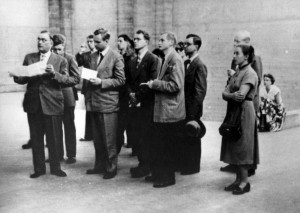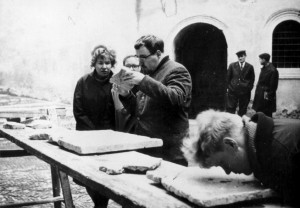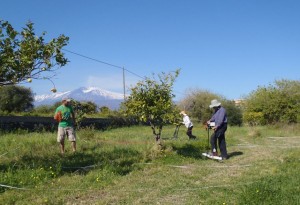[vc_row][vc_column width=”1/1″][text_output]

From the beginning of the 1950s the Institute’s own research activity has been based on the Director’s projects and the research groups created to study the varying themes.
The first director was Henrik Zilliacus (1908-1992), director from 1956 to 1959, and his work concentrated on Latin and Greek inscriptions. He and his students studied the Early Christian inscriptions in the Vatican Museum and their work was published in 1963 as the first volume of the Institute’s series, Acta Instituti Romani Finlandiae.
Zilliacus was followed by Veikko Väänänen (1905-1997, director 1959-1962) who continued work with inscriptions, but his focus was on the graffiti in the paedagogium and Domus Tiberiana on the Palatine Hill.

Jaakko Suolahti (1918-1987, director 1962-1965) tackled yet another group of Latin inscriptions, brick stamps. The main aim was to study and publish the brick stamps found in Ostia, but the project included also geological research on the provenance of the bricks. Roman building industry and its connections to the Roman society and economy were also studied widely and Eva Margareta Steinby became the most remarkable scholar in this field.[/text_output][text_output]The next director, Patrick Bruun (1920-2007, director 1965-1967) chose to study a new field: the disappearance of the Etruscans, particularly of their culture and language. The work of Bruun’s research group was published in 1975.
Veikko Väänänen returned for a second period as the Director in 1968. He returned to Latin inscriptions and with his students studied the funerary inscriptions from the necropolis on Via Triumphalis in the Vatican (so called Autoparco Vaticano cemetery).
Tuomo Pekkanen’s (director 1969-1972) research theme revolved around the first written sources on the Finnish people and tribes.
Henrik Lilius (director 1972-1976) was the first art historian selected as Director. His research group studied the decorations of Renaissance bathrooms (It. stufetta). He also published an important book on the architecture and decoration of Villa Lante.
Heikki Solin (director 1976-1979) returned to Latin epigraphy and worked on the history and culture and ancient Latium based on inscriptions.

Eva Margareta Steinby (director 1979-1982) conducted the first – and so far the only – excavations by the Institute during her period as the Director. The interdisciplinary project studied the area of Lacus Iuturnae on the Forum Romanum and published work on the history, literary sources and religious meaning of the monument. The excavation was completed in 1985 and published in two volumes. The first came out in 1991 and contains various sources and materials excavated by Giacomo Boni in the 19th century (Lacus Iuturnae I = Lavori e studi pubblicati dalla Soprintendenza archeologica di Roma 12). The second volume was published in 2012 and it contains the results of the excavations in the 1980s (Lacus Iuturnae II = Acta Instituti Romani Finlandiae 38).[/text_output][text_output]The next two directors studied Roman history. Veikko Litzen’s (1933-2011, director 1983-1986) project was on cultural changes in the Late Antiquity and Unto Paananen (1934-2009, director 1986-1989) studied Roman Republican legislation and particularly the role of the curiate assembly in it.
Anne Helttula’s (director 1989-1992) research group studied and re-published the Latin inscriptions of the necropoli of Isola Sacra at Portus.
Eva Margareta Steinby returned to the Institute 1992-1994 and researched Roman Republican and Imperial building activity.
Päivi Setälä (1943-2014, director 1994-1997) introduced a new theme as her research group studied Roman women and their economic status from the point of view of social and economic history.
Christer Bruun’s (director 1997-2000) period as Director coincided with a major renovation of Villa Lante, but his time was one of the most active in the Institute’s conference history.
Christian Krötzl (director 2000-2003) was the first Medieval historian to work as Director. His research theme was communication during the Medieval period.
Mika Kajava (director 2003-2006) returned to the ancient world and studied oracles in the Hellenistic and Roman world.
Kaj Sandberg (director 2006-2009) participated in the research group of Unto Paananen and continued Paananen’s work by concentrating on the development of the political system during the Roman Republic.
Katariina Mustakallio’s (director 2009-2013) research theme concerned social and religious history, particulary childhood, youth and socialization in ancient and medieval times.
Tuomas Heikkilä’s (director 2013-2017) research as a Medieval historian concentrated on time and calendars.
The current director (from 2017) Arja Karivieri will further her research on the development of Ostia and Portus, the harbour cities of ancient Rome from Late antiquity to the early Middle Ages.
In addition to the Director and his research group, many other scholars work at the Institute. Since 1965, the Foundation has awarded an annual grant for a young doctoral student with the help of the Jenny and Antti Wihuri Foundation. Many of the Wihuri Fellows have been classical scholars or historians, but theology, modern history and modern philology have also been represented. Another grant in collaboration with Waldemar von Frenckell’s Foundation was awarded 2005-2016 for a student of architecture.

In 1973 a second research post could be added to the Institute’s staff. Until 2009, the post was intended for doctoral students working on their dissertations, but currently the Vice Director is a post-doc researcher.
Archaeological excavations have been conducted in collaboration with various Soprintendze in the region of Rome as well as with Finnish universities and other institutes. The Nordic Institutes in Rome have had two joint excavations: the first in 1975-1980 in the ancient town of Ficana, between Rome and Ostia. The second project in 1998-2002 studied a Roman villa on the northern shore of the Lake Nemi.

Between 2013 and 2015 a research project was conducted on the Greek colony of Naxos in Sicily. The research project was a collaboration of the museum of Naxos and the Finnish institutes in both Rome and in Athens.
[/text_output][/vc_column][/vc_row]

